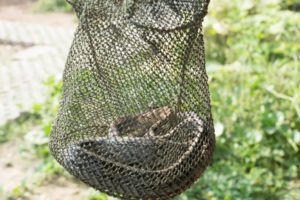 Snake repellents may scare the snakes for the time being, but there’s no guarantee that they will bar the snakes for life. Snake traps are the best alternatives that make sure the trouble-maker snake doesn’t return to your place. After all, you transport it miles away from your residence yourself and see it bugger off. However, the effectiveness of snake traps relies on the bait you use for luring snakes. So, what do you use for bait in a snake trap for it to successfully tempt the snake? That’s a question whose answer can make or break your entire game.
Snake repellents may scare the snakes for the time being, but there’s no guarantee that they will bar the snakes for life. Snake traps are the best alternatives that make sure the trouble-maker snake doesn’t return to your place. After all, you transport it miles away from your residence yourself and see it bugger off. However, the effectiveness of snake traps relies on the bait you use for luring snakes. So, what do you use for bait in a snake trap for it to successfully tempt the snake? That’s a question whose answer can make or break your entire game.
I have seen people lamenting snake traps on websites and in live meetings because the tools didn’t work on the snakes they wanted to catch. Somebody please tell them the fault lies in the wrong bait they have used. Use an effective bait, and the snake will have little will to ignore the trap.
In the article below, I have shared several bait options you can use to coax the serpent. You can pick the type of trap and bait according to the size and diet of the snake you plan to tackle.
Types of Baits for Snake Traps
Glue traps, minnow traps and maze traps are popular forms of traps people use to catch snakes. Snakes don’t just magically get caught in these traps. Some attractant, known as bait, lures them into the trap. Afterwards, the creature cannot flee and waits for you to let it lose wherever you feel satisfied.
Below are some of the common baits people use in snake traps.
-
Baits in Glue Traps
Glue traps are the most effective and budget-friendly form of snake-capturing tools. The adhesive pad immobilises the snake once it slithers onto the trap’s floor. Usually, you use rodent oil as bait to tempt the serpent. The poor creature follows the scent of the oil and gets stuck. Gotcha!
Moreover, people also use insects, worms or a living, breathing mouse as bait. These are found to be more effective than scent-based lures. The only problem with using a living rodent or lizard is that you cannot force it to stay in one place. That’s why people then opt for scent-based anime baits.
When you decide to set the prisoner free, neutralise the glue by pouring cooking oil on the reptile and adhesive layer. These traps are suitable for catching smaller snakes lurking indoors, not outdoors. When placed outdoors in the open, creatures like rodents or your pets may also get trapped. The strong adhesive may rip patches of their skin when they wrestle to get free.
-
Baits in Minnow Traps
A minnow trap is a practical choice for catching a snake loitering around in your yard, garden or any other outdoor area of the property. Here, the most effective baits you can pick are mice, rats or freshly laid eggs of birds or chickens. Simply place the bait in the middle of the trap to lure the reptile. The funnel-like structure allows easy entry to the invader snake. But, getting out is close to impossible for the prisoner.
People also use anime baits, such as substances smelling like rodents, toads or other favourite dishes of snakes. However, snakes aren’t interested in dead meat. So, these rarely work.
Minnow traps are great for imprisoning non-poisonous, grownup snakes.
-
Baits in Maze Traps
Once again, you will have higher chances of successfully luring the snake into the maze if you use live bait. Live rodents or fresh eggs of a hen or a bird will quickly capture a snake’s interest. You can also use a small and non-venomous snake as bait if you are trying to catch a poisonous coral snake or its lookalike kingsnake. These two are notorious for feeding on other snakes.
Besides, lizards and turtle eggs are also effective options for baits.
A Tip: When you are planning to trap a water snake, use hen’s or bird’s eggs as bait instead of rodents or toads. A water snake can easily hunt a frog in moist areas, so why would a trapped amphibian capture its interest? These meaty baits work better on ground snakes.
Final Words
Using different traps to catch serpents is better than other snake-deterring approaches because traps don’t harm them. The traps successfully ensnare snakes in their clutches because you use bait. Alive frogs, rodents and fresh eggs of hens or birds are some of the most popular and effective bait options you can use for traps. Commercial products like oils mimicking scents of live baits are also available, but there’s no guarantee of their success. So, if you want to ensure a snake falls in your trap, bait it with fresh eggs or live creatures.
